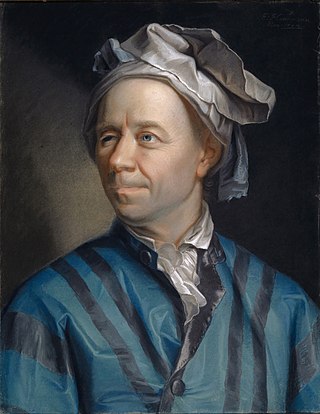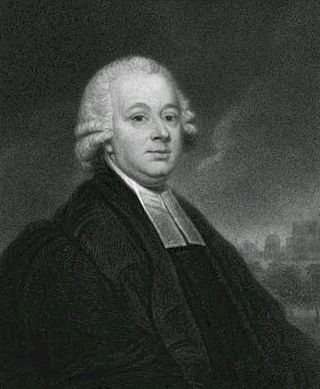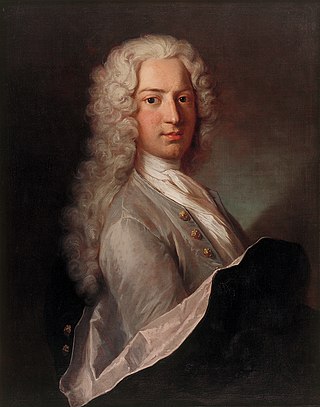Related Research Articles

Leonhard Euler was a Swiss mathematician, physicist, astronomer, geographer, logician, and engineer who founded the studies of graph theory and topology and made pioneering and influential discoveries in many other branches of mathematics such as analytic number theory, complex analysis, and infinitesimal calculus. He introduced much of modern mathematical terminology and notation, including the notion of a mathematical function. He is also known for his work in mechanics, fluid dynamics, optics, astronomy, and music theory.

1737 (MDCCXXXVII) was a common year starting on Tuesday of the Gregorian calendar and a common year starting on Saturday of the Julian calendar, the 1737th year of the Common Era (CE) and Anno Domini (AD) designations, the 737th year of the 2nd millennium, the 37th year of the 18th century, and the 8th year of the 1730s decade. As of the start of 1737, the Gregorian calendar was 11 days ahead of the Julian calendar, which remained in localized use until 1923.

1736 (MDCCXXXVI) was a leap year starting on Sunday of the Gregorian calendar and a leap year starting on Thursday of the Julian calendar, the 1736th year of the Common Era (CE) and Anno Domini (AD) designations, the 736th year of the 2nd millennium, the 36th year of the 18th century, and the 7th year of the 1730s decade. As of the start of 1736, the Gregorian calendar was 11 days ahead of the Julian calendar, which remained in localized use until 1923.

Nevil Maskelyne was the fifth British Astronomer Royal. He held the office from 1765 to 1811. He was the first person to scientifically measure the mass of the planet Earth. He created The Nautical Almanac, in full the British Nautical Almanac and Astronomical Ephemeris for the Meridian of the Royal Observatory at Greenwich using Tobias Mayer's corrections for Euler's Lunar Theory tables.

Daniel Bernoulli was a Swiss mathematician and physicist and was one of the many prominent mathematicians in the Bernoulli family from Basel. He is particularly remembered for his applications of mathematics to mechanics, especially fluid mechanics, and for his pioneering work in probability and statistics. His name is commemorated in the Bernoulli's principle, a particular example of the conservation of energy, which describes the mathematics of the mechanism underlying the operation of two important technologies of the 20th century: the carburetor and the aeroplane wing.

The longitude rewards were the system of inducement prizes offered by the British government for a simple and practical method for the precise determination of a ship's longitude at sea. The prizes, established through an Act of Parliament in 1714, were administered by the Board of Longitude.
The following is a timeline of classical mechanics:

Joseph-Louis Lagrange, also reported as Giuseppe Luigi Lagrange or Lagrangia, was an Italian mathematician, physicist and astronomer, later naturalized French. He made significant contributions to the fields of analysis, number theory, and both classical and celestial mechanics.

Galvanism is a term invented by the late 18th-century physicist and chemist Alessandro Volta to refer to the generation of electric current by chemical action. The term also came to refer to the discoveries of its namesake, Luigi Galvani, specifically the generation of electric current within biological organisms and the contraction/convulsion of biological muscle tissue upon contact with electric current. While Volta theorized and later demonstrated the phenomenon of his "Galvanism" to be replicable with otherwise inert materials, Galvani thought his discovery to be a confirmation of the existence of "animal electricity," a vital force which gave life to organic matter.

Luigi Galvani was an Italian physician, physicist, biologist and philosopher, who studied animal electricity. In 1780, he discovered that the muscles of dead frogs' legs twitched when struck by an electrical spark. This was an early study of bioelectricity, following experiments by John Walsh and Hugh Williamson.

The Commissioners for the Discovery of the Longitude at Sea, or more popularly Board of Longitude, was a British government body formed in 1714 to administer a scheme of prizes intended to encourage innovators to solve the problem of finding longitude at sea.
The year 1744 in science and technology involved some significant events.
The year 1777 in science and technology involved some significant events.
The year 1798 in science and technology involved some significant events.
The year 1760 in science and technology involved some significant events.
The year 1757 in science and technology involved some significant events.
The year 1736 in science and technology involved some significant events.

In celestial navigation, lunar distance, also called a lunar, is the angular distance between the Moon and another celestial body. The lunar distances method uses this angle and a nautical almanac to calculate Greenwich time if so desired, or by extension any other time. That calculated time can be used in solving a spherical triangle. The theory was first published by Johannes Werner in 1524, before the necessary almanacs had been published. A fuller method was published in 1763 and used until about 1850 when it was superseded by the marine chronometer. A similar method uses the positions of the Galilean moons of Jupiter.
References
- ↑ Bakich, Michael E. (2000). The Cambridge Planetary Handbook. Cambridge University Press. p. 103. ISBN 9780521632805.
- ↑ "On the cause of the eccentricity of the woody layers which one perceives when one cuts horizontally the trunk of a tree" (De la cause de l'excentricité des couches ligneuses qu'on apperçoit quand on coupe horisontalement le tronc d'un arbre).
- ↑ "A Curious Herbal". The British Library. Retrieved 21 March 2019.
- ↑ Duffin, C. J.; Gardner-Thorpe, C.; Moody, R. T. J. (2017). Geology and Medicine: Historical Connections. Geological Society of London. p. 60. ISBN 9781786202833.
- ↑ Gates, Alexander E.; Ritchie, David (2006). Encyclopedia of Earthquakes and Volcanoes. Infobase Publishing. p. 38. ISBN 9780816072705.
- ↑ Dasgupta, Samir; Şiriner, İsmail; De, Partha Sarathi (2010). Women's Encounter with Disaster. ismail siriner. p. 250. ISBN 9788190884143.
- ↑ Euler, Leonhard (1737). "Variae observationes circa series infinitas" [Various observations concerning infinite series]. Commentarii Academiae Scientiarum Petropolitanae. 9: 160–188.
- ↑ "Longitude found: John Harrison". Royal Museums Greenwich | UNESCO World Heritage Site In London. 7 October 2015. Retrieved 21 March 2019.
- ↑ Ritchie, Stefka (2018). Samuel Johnson's Pragmatism and Imagination. Cambridge Scholars Publishing. p. 76. ISBN 9781527521094.
- ↑ "medal". British Museum. Retrieved 21 March 2019.
- ↑ "Luigi Galvani | Italian physician and physicist". Encyclopedia Britannica. Retrieved 21 March 2019.